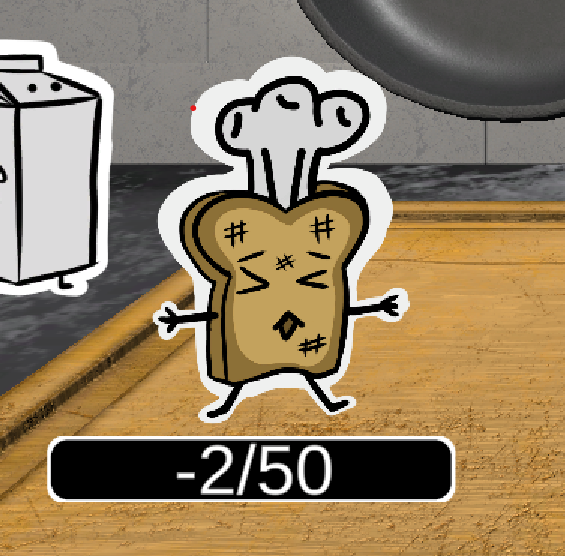Sandwich Stacker
A turn-based RPG designed for a Taiko drum controller, utilizing QTE’s and enemy variety to create a unique experience.
Made for PC using Unity
Cooper Thronson, Hayden McManus, Jesse Mazza, William Badger, Xavier Olmstead, Darin Hinze
05/08/2023
Systems/Mechanics/Combat Designer
QA Manager
Sandwich Stacker was created with the intent of expanding my skills to different genres of games, as I had not worked on a turn-based game before. I worked as the main systems and combat designer on this project, along with being our QA manager and balance designer.
Our team worked quite healthily with each other throughout the entirety of this project. We had stable and established pipelines for all of our disciplines, and we all respected each other’s roles as professionals. While we did not get to complete everything we wanted to on this project due to time constraints, our team was very friendly and efficient all throughout.
If we had more time, our biggest plans for additions were a method of blocking enemy attacks, allowing for more player skill expression by defending at the right time to lower damage taken. This would also allow for more diverse combat as the player could have less health, and it would become more of actual combat rather than what it is now, which is effectively a puzzle game disguised as turn based combat. Our other biggest wish for additions would be more enemies overall, as adding more mechanics and variables for the player to think about would lead to a more engaging experience overall. I would have liked to change the combat system to only let melee attacks target the frontmost enemy as well, as that could also enable our combat systems to be more dynamic and shift with what enemies are currently alive. Our team was overall satisfied with the end product, with everyone contributing to what they wanted to, and having a decently polished product, while not perfect.
Sandwich Stacker is a linear turn based combat game that ties all of the players attacks to QTEs through their taiko drum controller. To defeat the waves of enemies the player must use unique attacks to exploit enemies weaknesses, while hitting the QTEs properly to maximize their damage output.
The screen rewarded for completing the game, where Breadward has become a sandwich.
We wanted to play into typical drum patterns for the gameplay, so the QTE for the player’s basic attack was to perform a drum roll, where the player had to alternate hitting each side of the taiko drum controller to fill up a bar within two seconds. If they failed, the attack would do half as much damage.
As the QA manager of this project, I took this game to our testing lab every week to receive feedback from players, and iterate upon our game accordingly. This led to a lot of rebalancing of the difficulty of our game, which when we first took it was almost impossible to complete unless you took a very specific order of actions. If you messed up 1 QTE, you basically could not win, so that had to change. Over the course of the project many variables changed such as player health, enemy and player damage, and combat structure. Due to our time constraints not allowing us to explore this more in depth, we landed on the decision of having the player regenerate 15 health every time they cleared a wave, which made the game much more feasible for newer players. In the end the game is quite easy now, but with what we were given it was the best we could do.
The player in the first combat encounter, against 3 tomatoes.
The basic concept of the game was you played as a lone slice of bread named Breadward, who has always wanted to become a sandwich. He must fight his way through the kitchen of opposing ingredients to finally turn himself into the sandwich he always desired to be.
The 3 enemies for the player to challenge, being the basic tomato, flying ham, and armored cheese.
QTE for the drum roll, where the player is prompted to hit both sides of the drum to fill up the sandwich shaped meter.
Outside of our QTE system, we wanted unique enemies for the player to interact with, so they had to think about how they approached combat more. This led to our 2 enemies other than the tomato, the ham and the cheese. The ham was flying, and could only be hit down by projectiles, which the only one existing being the players tomato toss. As for the cheese, he had a layer of wax protecting him from damage, so the player has to spend a turn exclusively removing that, which leads to player decisions of if they have the time to do that, or if other enemies are the main threat. We worked with Unity’s scriptable objects for our attacks and enemies, allowing for quick prototyping and merging of mechanics, such as if we wanted to have an enemy that both flew and had armor, all it would take is tweaking of some variables, and checking off both of the flying and armored variables on the object. If this project were to have gone further past its given time, the expansion of these systems would have been very streamlined.
Breadward Perishing.







